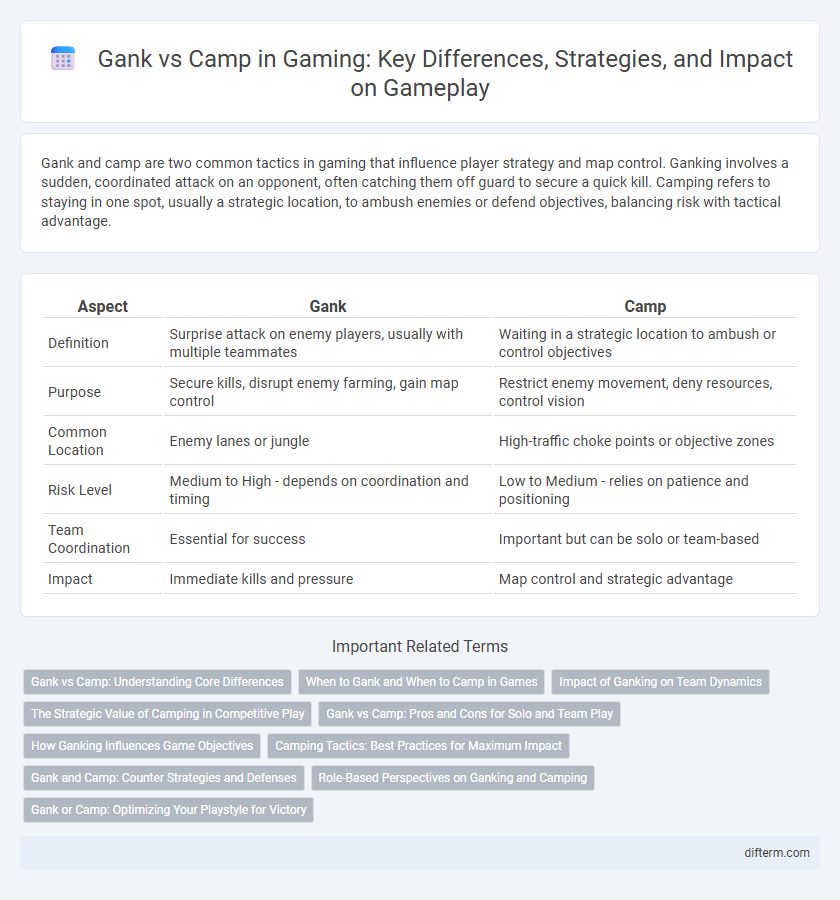Gank and camp are two common tactics in gaming that influence player strategy and map control. Ganking involves a sudden, coordinated attack on an opponent, often catching them off guard to secure a quick kill. Camping refers to staying in one spot, usually a strategic location, to ambush enemies or defend objectives, balancing risk with tactical advantage.
Table of Comparison
| Aspect | Gank | Camp |
|---|---|---|
| Definition | Surprise attack on enemy players, usually with multiple teammates | Waiting in a strategic location to ambush or control objectives |
| Purpose | Secure kills, disrupt enemy farming, gain map control | Restrict enemy movement, deny resources, control vision |
| Common Location | Enemy lanes or jungle | High-traffic choke points or objective zones |
| Risk Level | Medium to High - depends on coordination and timing | Low to Medium - relies on patience and positioning |
| Team Coordination | Essential for success | Important but can be solo or team-based |
| Impact | Immediate kills and pressure | Map control and strategic advantage |
Gank vs Camp: Understanding Core Differences
Gank in gaming refers to a sudden, concentrated attack by multiple players targeting an isolated enemy to secure a quick kill, leveraging surprise and teamwork for tactical advantage. Camp involves one or more players remaining in a strategic location to control vision, deny resources, or repeatedly ambush opponents as they pass through, emphasizing map control and psychological pressure. Understanding the core differences between gank and camp is essential for effective matchmaking, resource allocation, and mastering strategic gameplay in multiplayer online battle arenas.
When to Gank and When to Camp in Games
Ganking is most effective during early to mid-game when enemy players are isolated or overextended, enabling quick kills and map pressure. Camping is suited for late-game or objective-heavy situations where controlling vision and denying enemy movements provide strategic advantages. Understanding enemy cooldowns, positioning, and team power spikes determines the optimal choice between ganking and camping in competitive gameplay.
Impact of Ganking on Team Dynamics
Ganking disrupts enemy strategies by applying sudden pressure on isolated targets, forcing opponents to play cautiously and often pulling resources from other lanes to respond. This tactical aggression can create opportunities for the ganker's team to secure objectives like towers, dragons, or buffs, thereby accelerating map control and overall momentum. Effective ganks enhance team coordination and communication, fostering trust and synchronization among players while simultaneously destabilizing enemy cohesion and resource allocation.
The Strategic Value of Camping in Competitive Play
Camping in competitive gaming serves as a strategic tool to control key areas, deny enemy resources, and secure objectives by maintaining map presence. Effective camping disrupts opponent rotations and creates opportunities for ambushes, forcing adversaries into defensive or predictable plays. Mastering campsite positioning enhances team coordination and increases the chances of winning critical engagements through vision control and pressure application.
Gank vs Camp: Pros and Cons for Solo and Team Play
Gank strategies create surprise attacks to quickly eliminate high-value targets, offering fast momentum gains in both solo and team play, but risk exposing the ganker to counterattacks if poorly timed. Camp tactics involve controlling key map areas to deny enemy resources and vision, benefiting team coordination by setting traps and ambushes, while potentially stalling gameplay and becoming predictable. Solo players may struggle with extended camping due to lack of backup, whereas teams can leverage coordinated camps to secure objectives and amplify map control.
How Ganking Influences Game Objectives
Ganking strategically disrupts enemy rotations and creates numerical advantages, accelerating objective control such as securing dragons and towers. Successful ganks impose pressure on opposing lanes, forcing defensive play that delays enemy advances and reduces map control. This dynamic fosters momentum shifts, enabling teams to capitalize on objectives and snowball towards victory.
Camping Tactics: Best Practices for Maximum Impact
Camping tactics in gaming maximize map control and pressure by securing key choke points and objectives, forcing enemy teams into unfavorable engagements. Effective camp placement involves utilizing vision tools like wards and exploiting high-traffic zones to anticipate enemy movements. Maintaining communication with teammates and rotating camps dynamically can overwhelm opponents, disrupt their farming patterns, and create opportunities for decisive team fights.
Gank and Camp: Counter Strategies and Defenses
Effective counter strategies against gank tactics in gaming involve vigilant map awareness, strategic ward placement, and swift team communication to anticipate enemy movements. Defenses against camping hinge on maintaining vision control, timely rotations to relieve pressure, and leveraging terrain advantages to disrupt enemy ambush points. Balancing offensive and defensive maneuvers mitigates risks from ganks and camps, ensuring sustained map control and objective security.
Role-Based Perspectives on Ganking and Camping
In gaming, ganking involves coordinated surprise attacks to quickly eliminate key enemy players, often executed by roaming assassins or junglers aiming to create numerical advantages. Camping is a defensive tactic where players, typically supports or tanks, stay in one location to control objectives or ambush opponents, prioritizing map control and vision dominance. Understanding role-specific objectives helps teams balance aggressive ganking with strategic camping to optimize overall game strategy and momentum.
Gank or Camp: Optimizing Your Playstyle for Victory
Mastering gank strategies boosts map control and surprise attacks, enabling quick eliminations and momentum shifts. Camping offers defensive dominance by controlling key objectives and forcing enemy mistakes through sustained presence. Balancing aggressive ganks with strategic camping maximizes team synergy and overall victory potential.
Gank vs Camp Infographic

 difterm.com
difterm.com